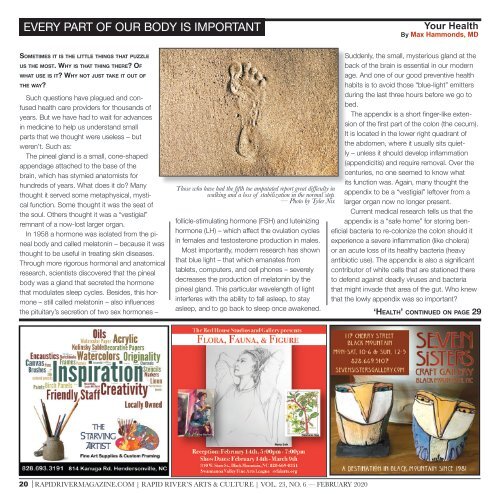February 2020 Issue
Works of art defining the contemporary age in WNC. Cover: ‘Downtown,’ 24x24, by Mark Bettis
Works of art defining the contemporary age in WNC.
Cover: ‘Downtown,’ 24x24, by Mark Bettis
You also want an ePaper? Increase the reach of your titles
YUMPU automatically turns print PDFs into web optimized ePapers that Google loves.
EVERY PART OF OUR BODY IS IMPORTANT<br />
Your Health<br />
By Max Hammonds, MD<br />
Sometimes it is the little things that puzzle<br />
us the most. Why is that thing there? Of<br />
what use is it? Why not just take it out of<br />
the way?<br />
Such questions have plagued and confused<br />
health care providers for thousands of<br />
years. But we have had to wait for advances<br />
in medicine to help us understand small<br />
parts that we thought were useless – but<br />
weren’t. Such as:<br />
The pineal gland is a small, cone-shaped<br />
appendage attached to the base of the<br />
brain, which has stymied anatomists for<br />
hundreds of years. What does it do? Many<br />
thought it served some metaphysical, mystical<br />
function. Some thought it was the seat of<br />
the soul. Others thought it was a “vestigial”<br />
remnant of a now-lost larger organ.<br />
In 1958 a hormone was isolated from the pineal<br />
body and called melatonin – because it was<br />
thought to be useful in treating skin diseases.<br />
Through more rigorous hormonal and anatomical<br />
research, scientists discovered that the pineal<br />
body was a gland that secreted the hormone<br />
that modulates sleep cycles. Besides, this hormone<br />
– still called melatonin – also influences<br />
the pituitary’s secretion of two sex hormones –<br />
Those who have had the fifth toe amputated report great difficulty in<br />
walking and a loss of stabilization in the normal step.<br />
— Photo by Tyler Nix<br />
follicle-stimulating hormone (FSH) and luteinizing<br />
hormone (LH) – which affect the ovulation cycles<br />
in females and testosterone production in males.<br />
Most importantly, modern research has shown<br />
that blue light – that which emanates from<br />
tablets, computers, and cell phones – severely<br />
decreases the production of melatonin by the<br />
pineal gland. This particular wavelength of light<br />
interferes with the ability to fall asleep, to stay<br />
asleep, and to go back to sleep once awakened.<br />
Suddenly, the small, mysterious gland at the<br />
back of the brain is essential in our modern<br />
age. And one of our good preventive health<br />
habits is to avoid those “blue-light” emitters<br />
during the last three hours before we go to<br />
bed.<br />
The appendix is a short finger-like extension<br />
of the first part of the colon (the cecum).<br />
It is located in the lower right quadrant of<br />
the abdomen, where it usually sits quietly<br />
– unless it should develop inflammation<br />
(appendicitis) and require removal. Over the<br />
centuries, no one seemed to know what<br />
its function was. Again, many thought the<br />
appendix to be a “vestigial” leftover from a<br />
larger organ now no longer present.<br />
Current medical research tells us that the<br />
appendix is a “safe home” for storing beneficial<br />
bacteria to re-colonize the colon should it<br />
experience a severe inflammation (like cholera)<br />
or an acute loss of its healthy bacteria (heavy<br />
antibiotic use). The appendix is also a significant<br />
contributor of white cells that are stationed there<br />
to defend against deadly viruses and bacteria<br />
that might invade that area of the gut. Who knew<br />
that the lowly appendix was so important?<br />
‘Health’ continued on page 29<br />
20 |RAPIDRIVERMAGAZINE.COM | RAPID RIVER’S ARTS & CULTURE | VOL. 23, NO. 6 — FEBRUARY <strong>2020</strong>















